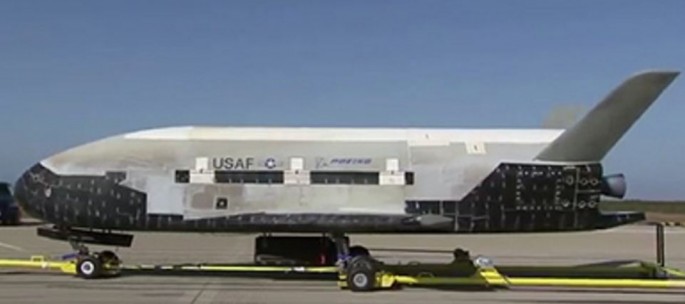It would be great to know if the Boeing X-37B spaceplane of the U.S. Air Force is testing an EmDrive engine but the Air Force isn't saying.
What's certain is this hush-hush spaceplane has been orbiting the Earth for 600 days and in 74 more days will set a new world record for the longest time in Earth orbit by a spacecraft.
Also known as the Orbital Test Vehicle (OTV), the X-37B's latest mission is identified as OTV-4. This mission blasted-off from Cape Canaveral Air Force Station in Florida on May 20, 2015 aboard a United Launch Alliance Atlas V rocket.
As with the previous three OTV missions, the Air Force is tight-lipped about the purpose of this latest mission. Speculation abounds, however.
There are persistent reports the Air Force is testing a working version of the controversial EmDrive electromagnetic thruster aboard on the OTV-4 mission.
If true, the report of an EmDrive aboard the X-37B might help explain why the spaceplane remains in orbit well past its announced mission life of 200 days.
Also called a radio frequency (RF) resonant cavity thruster, an EmDrive or Em Drive uses no reaction mass and emits no directional radiation to generate thrust. British aerospace engineer Roger Shawyer designed the EmDrive in 2001 and has promoted the idea through his company, Satellite Propulsion Research.
While the Air Force hasn't confirmed speculation an EmDrive is being tested aboard the spaceplane, what is certain is the X-37B is testing a prototype "Hall Effect Thruster" (HET) in support of the Air Force's Advanced Extremely High Frequency (AEHF) communications satellite program.
The in-orbit tests include collection of telemetry from the Hall Thruster operating in the space environment, as well as measurement of the thrust imparted on the vehicle.
The U.S. Department of Defense said operational Hall Effect Thrusters or Hall Thrusters will propel military satellites (milsats) in Earth orbit or power future spacecraft on interplanetary voyages.
As a propulsion system for future U.S. space weapons, HETs will also allow the U.S. to maintain persistent orbital capabilities and lead to the development of killer satlets (small satellites); parasite satellites that attach themselves to enemy satellites to destroy them and other foreign satellite manipulation technologies.
HETs will give these milsats more maneuvering capability while granting more control over their operations.
A Hall Thruster is a type of ion thruster in which the propellant is accelerated by an electric field. It can operate on a variety of propellants, the most common being xenon. Other propellants of interest include krypton, argon, bismuth, iodine, magnesium and zinc.
Hall Thrusters are able to accelerate their exhaust to speeds between 10 km/s (36,000 km/h) to 80 km/s (288,000 km/h) with most models operating between 15 km/s (54,000 km/h) to 30 km/s (108,000 km/h).



























